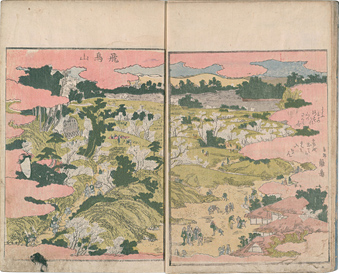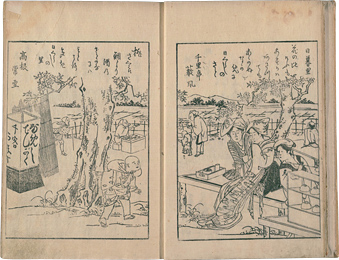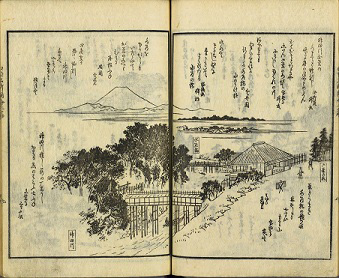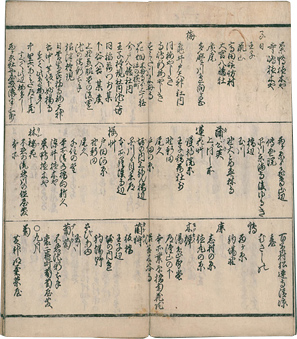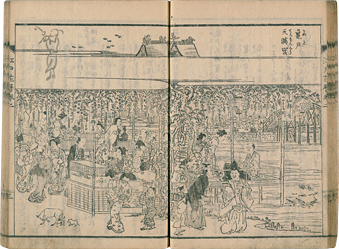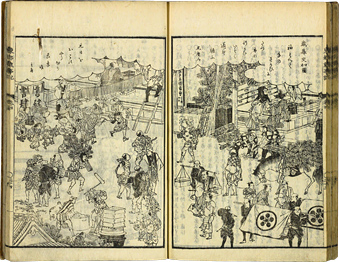Edo guidebooks
In Edo, books introducing meisho (famous places), meiten (famous shops) and meibutsu (famous products) were sold, much like modern day guidebooks. These guidebooks were used not only by people visiting Edo, but by Edo residents as well, holding the guidebook in one hand as they enjoyed travelling around famous places. These guidebooks also became popular as souvenirs from Edo. The National Diet Library also maintains a large number of these guidebooks in its collections. Please enjoy the prosperity of the meisho in Edo from those times.
Guidebooks
Edo Meishoki  by Asai Ryoi, printed by Kono Michikiyo in 1662 <Call no. : 京-21>
by Asai Ryoi, printed by Kono Michikiyo in 1662 <Call no. : 京-21>
These books were published by Kono Michikiyo in Kyoto in 1662. These are the oldest existing illustrated guides to meisho in Edo. The author is not noted but it was said to be Asai Ryoi. In the preface written by the author, the author states the spring weather tempted him to go out for a walk, and he met a friend and the two of them began to converse about visiting the meisho of Edo and decided upon the order of visiting the famous places at a tea house. This series covers 81 famous locations in 7 volumes with illustrations of each famous place and each description ending with a waka poem. The vast majority of the meisho are temples and shrines, however there are also descriptions of the bustling Nihon-bashi Bridge, kabuki and joruri plays.
Edo suzume  12 volumes, by Kinko Entsu ; illus. Hishikawa Moronobu, printed by Tsuruya Kiemon in 1677 <Call no. : 京-22>
12 volumes, by Kinko Entsu ; illus. Hishikawa Moronobu, printed by Tsuruya Kiemon in 1677 <Call no. : 京-22>
The first illustrated geographical booklet published in Edo in 1677. According to the author preface, he was requested by a friend visiting him from the country to write a guide to samurai residences, temples and shrines, famous and historical locations and other destinations. This book is treasured as material on the manners and customs of the day and includes 35 illustrations by the painter Hishikawa Moronobu.
Kokyo gaeri no Edo banashi  by Kagiya Heiemon, et al. in 1687, 8 books <Call no. : 本別19-5>
by Kagiya Heiemon, et al. in 1687, 8 books <Call no. : 本別19-5>
This work was published in1687. Both the text and illustrations are similar to Edo Meishoki and Edo Suzume. In the author preface, it is written that the author, who had lived in Edo for many years, thought of using seeing all the sites as a topic for a travel story before returning to his hometown.
Murasaki no hitomoto  by Toda Mosui copied in 1714, 2 books <Call no. : 寄別5-2-3-1>
by Toda Mosui copied in 1714, 2 books <Call no. : 寄別5-2-3-1>
Consists of 2 volumes. Completed in circa 1683. Dramatized as a trip of 2 people touring around Edo, the author portrayed various scenic and historical locations. It is said this work began as an attempt to classify place names in categories of hills, bridges and valleys.
Edo sunago  6 volumes, by Kikuoka Senryo and Tajihi Chikatomo, printed by Suharaya Ihachi, et al. in 1772 <Call no. : 840-1>
6 volumes, by Kikuoka Senryo and Tajihi Chikatomo, printed by Suharaya Ihachi, et al. in 1772 <Call no. : 840-1>
A revision of the geographical booklet Edo Sunago Onko Meisekishi published in 1732 [291.36-Ki147e]). It is also known as the Saiko Edo Sunago Onko Meisekishi and Saiko Kohu Meisekishi. This work corrects the text mistakes of the original edition and also notes the changes of place names and people names after 1732. Items added in the new edition are noted as "supplementary", highlighting all differences with the original edition. The work starts with an overview of Musashi Province and the area inside of the moat of Edo Castle, then is divided by directions, using Edo Castle as a center point, and provides historical investigations on town names, gates and bridges as well as the origins of temples and shrines and history of famous and historical places using older documents as sources. Together with the original edition, this is the most disseminated of the Edo geographical booklets.
Funai biko  edited by Mishima Masayuki and Kamiya Nobuyori, copy, 45 books <Call no.: 寅-13>
edited by Mishima Masayuki and Kamiya Nobuyori, copy, 45 books <Call no.: 寅-13>
Funai biko zokuhen edited by Mishima Masayuki and Kamiya Nobuyori, copy, 52 books <Call no.: 239-1>
The only geographical booklet on Edo compiled by the Edo Shogunate. Also known by the separate title Gofunai Biko. This work was organized to serve as reference for the Gofunai Fudoki to be compiled by the Tokugawa Shogunate, and was compiled in 2 parts consisting of a principal part and a sequel from 1826 to 1830. The 145 volumes of the main part contain articles on Edo Castle, streets, historic spots, etc. The 147 volumes of the sequel are also known as the Gofunai Jisha Biko and contain information on the origins and historic associations of temples and shrines. The Gofunai Fudoki was lost in the fire at the imperial palace in 1872, however the Gofunai Biko escaped intact.
Edo hanjoki  by Terakado Seiken, printed in 1832-36, 6 books (bound in 3 volumes) <Call no. : 840-13>
by Terakado Seiken, printed in 1832-36, 6 books (bound in 3 volumes) <Call no. : 840-13>
A geographical booklet on Edo written in classical Chinese. Published from 1832 to 1836. Written from the keen viewpoint of Terakado Seiken (1796-1868), this work won great praise from intellectuals. However, because the work was severely satirized the way of life of the samurai, priests and Confucians, the printing blocks for the work were confiscated and burned as being a work that corrupted public morals during the Tenpo Reforms (1841-43).
Edo meisho zue  7 volumes by Saito Choshu, illus. Hasegawa Settan, printed by Suharaya Mohei, et al. in 1834-1836, 20 books <Call no. : 839-57>
7 volumes by Saito Choshu, illus. Hasegawa Settan, printed by Suharaya Mohei, et al. in 1834-1836, 20 books <Call no. : 839-57>
Published from 1834 to 1836. This is an illustrated geographical booklet of meisho in Edo and surrounding areas. It has been praised as a comprehensive geographical booklet on Edo. The work was compiled by three generations of fathers and son, Saito Yukio (Choshu), Yukitaka (Kansai) and Yukinari (Gesshin). Consists of 7 volumes and 20 issues. Illustrations are by Hasegawa Settan. The work is written as on-site investigations of the history and current conditions of shrines, Buddhist temples and meisho and historical sites, and is of very high historical value. In particular, the drawings of Settan, that conveyed the customs, events and scenery, were sketches of the actual locations, with many portraying the scenes in extreme detail, making this work an extremely good historical reference of the scenery and customs of the time. The National Diet Library also holds a manuscript copy of the Koyu Manroku [134-270] which is a record of Yukitaka's site surveys.
Books for enjoying Meisho-e (pictures of famous places)
Ehon Edo miyage  2 parts, 6 volumes, by Nishimura Shigenaga, illus. Suzuki Harunobu, printed by Kikuya Yasubei <Call no. : わ-54>
2 parts, 6 volumes, by Nishimura Shigenaga, illus. Suzuki Harunobu, printed by Kikuya Yasubei <Call no. : わ-54>
The first edition was illustrated by Nishimura Shigenaga in 1753. After Nishimura passed away, a sequel using illustrations by Suzuki Harunobu was published in 1768, and the series is an illustrated book that introduces meisho that were popular in Edo over a long period of approximately 100 years.
Ehon Toto asobi  3 volumes, by Asakusa'an, illus. Katsushika Hokusai in 1802? <Callno. : か-46>
3 volumes, by Asakusa'an, illus. Katsushika Hokusai in 1802? <Callno. : か-46>
The Kyoka Azuma Asobi ![]() , printed in 1799, included illustrations of Edo meisho in the kyoka (a comic variant of the 31-syllable waka), however, in this document other than the kyoka, the illustrations were all printed with colors. The paintings are by Katsushika Hokusai.
, printed in 1799, included illustrations of Edo meisho in the kyoka (a comic variant of the 31-syllable waka), however, in this document other than the kyoka, the illustrations were all printed with colors. The paintings are by Katsushika Hokusai.
Edo meisho zue  written and illustrated by Juppensha Ikku in [1813?] <Call no. : 京-254>
written and illustrated by Juppensha Ikku in [1813?] <Call no. : 京-254>
A kyoka (a comic variant of the 31-syllable waka) picture book. Also known as the Ehon Edo Meisho. The work features 51 kyoka poems on the scenery and customs of Edo meisho in addition to a foreword and illustrations by Jippensha Iku, who was a playwright from the latter half of the Edo Era. One of his most famous works was the humorous story Tokaidochu Hizakurige.
Ehon Edo miyage  10parts, by Shotei Kinsui, illus. Ichiryusai Hiroshige and Hiroshige II printed by Kikuya Saburo, et al. <Call no. : 120-84>
10parts, by Shotei Kinsui, illus. Ichiryusai Hiroshige and Hiroshige II printed by Kikuya Saburo, et al. <Call no. : 120-84>
Published from 1850 to 1967. It is said that the first Hiroshige worked on editions 1-7 and after Hiroshige's death, Hiroshige II worked on editions 8-10. The work sold well and was reprinted many times. The author's foreword laments the loss by fire of woodblocks of Ehon Edo Miyage (↑) which inspired the author to describe current conditions in the work.
Kyoka Edo meisho zue  16 parts, edited by Tenmei rojin, illus. Hiroshige in 1856? <Call no. : 200-140>
16 parts, edited by Tenmei rojin, illus. Hiroshige in 1856? <Call no. : 200-140>
This work is in the style of the Edo Meisho Zue ![]() and arranges and describes Edo famous and historical places, temples and shrines, resorts, famous shops and other items in kyoka (a comic variant of the 31-syllable waka). Editions 1-14 were illustrated by the first Hiroshige with a portion of editions 5 and 6 and editions 15 and 16 illustrated by Hiroshige II.
and arranges and describes Edo famous and historical places, temples and shrines, resorts, famous shops and other items in kyoka (a comic variant of the 31-syllable waka). Editions 1-14 were illustrated by the first Hiroshige with a portion of editions 5 and 6 and editions 15 and 16 illustrated by Hiroshige II.
Shopping and gourmet
Edo kaimono hitori an'nai  2 volumes and 1 supple., edited by Nakagawa Gorozaemon, printed by Yamashiroya Sahei, et al. in 1824 <Call no. : 123-229>
2 volumes and 1 supple., edited by Nakagawa Gorozaemon, printed by Yamashiroya Sahei, et al. in 1824 <Call no. : 123-229>
Composed of 3 volumes, first, second and a food and drink volume, and introduces approximately 2,600 shops. The first volume has a foreword by Ota Nanpo. Article names are listed in Japanese "i-ro-ha" order, with addresses and store names listed.
Edo meibutsu shuhan tebikigusa  printed in 1847 <Call no. : に-65>
printed in 1847 <Call no. : に-65>
An advertisement book which also served as a list of kaiseki cuisine, loach, sushi, soba noodle and other restaurants. The work imitates the style of the Edo kaimono hitori an'nai.
Hanagoyomi (floral calendar) and saijiki (compendium of seasonal words)
Miyabi no shiori  by Kigisunoya Norifusa, printed by Kitajima Junsiro in 1834 1 book,<Call no. : 特1-3144>
by Kigisunoya Norifusa, printed by Kitajima Junsiro in 1834 1 book,<Call no. : 特1-3144>
In the latter part of the Edo Period guidebooks to the Edo kachofugetsu (beauties of nature) were printed and this work is one of these materials. This is a list of Edo meisho including 150 kachofugetsu, possibly the largest number of any hanagoyomi (floral calendar). If folded into a small pamphlet, it was very portable at about the size of a modern day ippitsusen (vertical Japanese notepad).
Edo yuran hanagoyomi  4 volumes by Oka Sancho, et al., printed by Suharaya Ihachi, et al. in 1837 <Call no. : 特1-1952>
4 volumes by Oka Sancho, et al., printed by Suharaya Ihachi, et al. in 1837 <Call no. : 特1-1952>
Printed in 1827. Also referred to as the Edo Meisho Hanagoyomi (Edo famous places floral calendar). Lists the names of 43 objects or scenery characteristic of a season such as Japanese nightingale, ume plum trees and cherry blossoms for the spring and Japanese wisteria and fireflies for the summer, and introduces meisho from Edo and surrounding areas for each entry. A guide to meisho that also included the locations, details and origins of the places.
Seibo koka zu ![]()
An advertisement for the Edo meisho zue
visible in the center of the page.
Toto Saijiki  4 volumes and 1 supple., edited by Saito Yukinari, illus. Hasegawa Settan and Hasegawa Settei, printed by Suharaya Ihach, et al. in 1838 <Call no. : 121-85>
4 volumes and 1 supple., edited by Saito Yukinari, illus. Hasegawa Settan and Hasegawa Settei, printed by Suharaya Ihach, et al. in 1838 <Call no. : 121-85>
Divided by the four seasons and describes in detail the various events and natural features of the season of Edo throughout the year.
Bibliography
- Ikegami Mayumi, Edo shomin no shinko to koraku, Doseisha, 2002 <Call no. : GD15-G135>
- Shirai Tetsuya, Nihon kinse chishi hensansi kenkyu, Shibunkaku shuppan, 2004 <Call no. : GB52-H25>
- Nagasawa Kikuya, Edo chishi kaisetuko, 1932 <Call no. : 291.36-N191e5>









